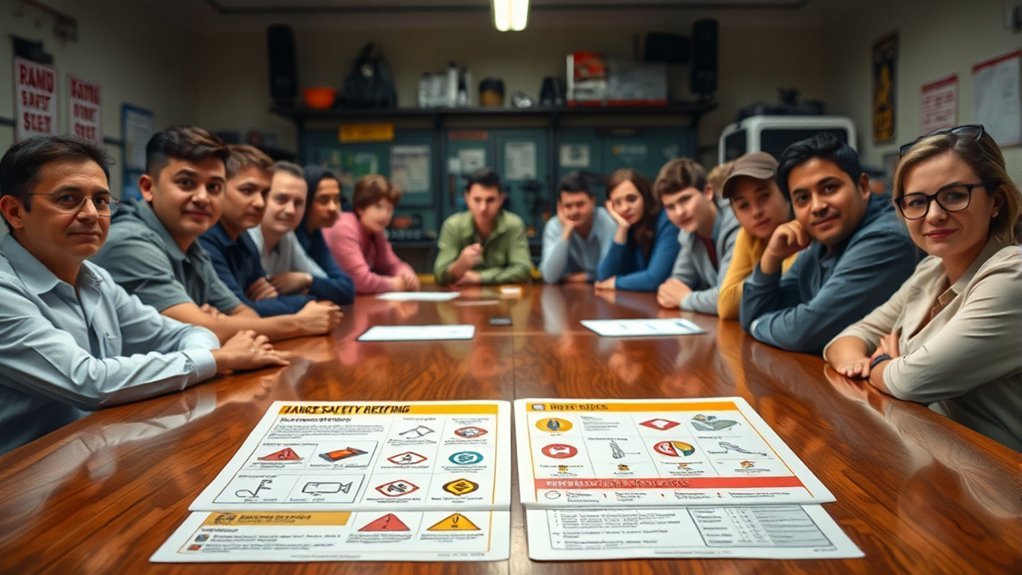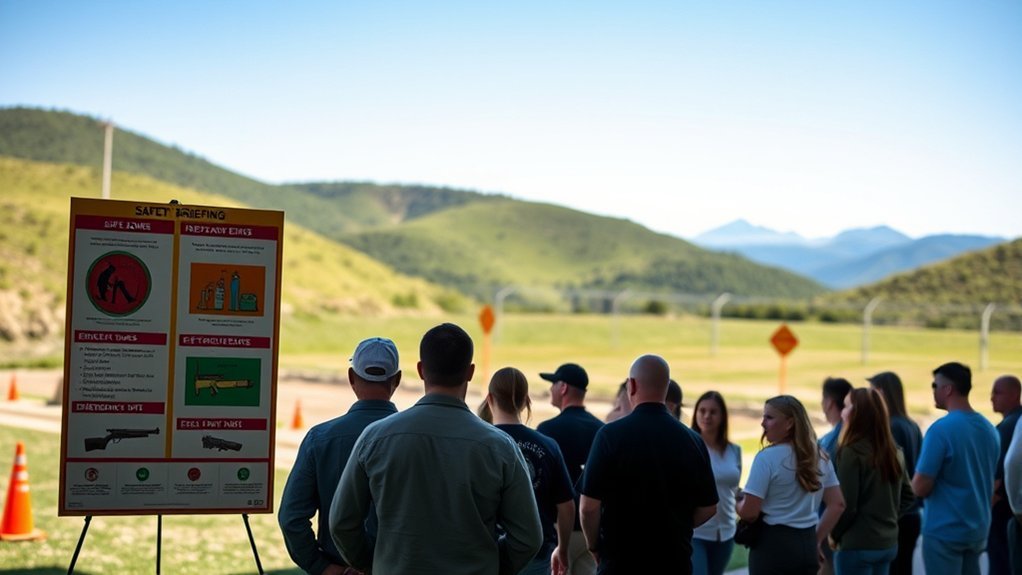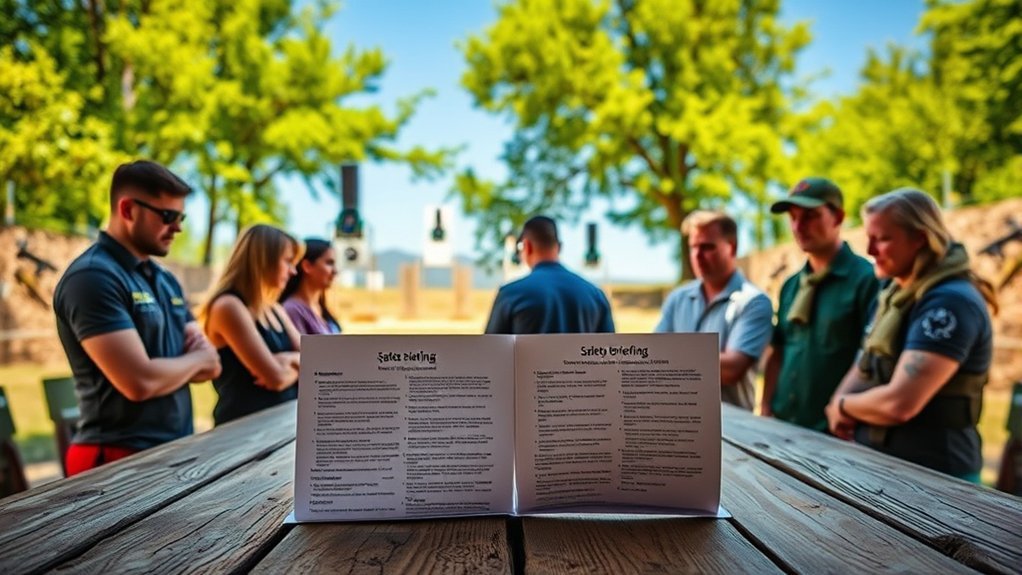Like a pilot reviewing a flight plan, you must approach a range safety briefing with focus and precision. It’s essential to grasp the key rules and regulations that govern safe firearm handling. Understanding the designated safe areas and emergency procedures can make all the difference in a critical moment. But there’s more to this briefing than just rules. What else should you keep in mind to guarantee a secure shooting experience?
Understanding the Importance of Range Safety Briefings
When you step onto a shooting range, understanding the importance of the safety briefing is essential. This briefing is your first line of defense in promoting gun safety. It outlines vital rules that prevent accidents, like muzzle direction and handling misfires. You’ll learn about the range layout, including designated shooting areas and boundaries, which are key for maintaining a safe environment. The briefing also emphasizes the necessity of personal protective equipment, such as eye and ear protection, to mitigate risks. By grasping and adhering to the information presented, you foster a culture of safety and responsibility among all participants. Prioritizing these briefings sets the foundation for a secure shooting experience, ensuring everyone can enjoy their time safely.
Key Rules and Regulations to Follow

Understanding and following key rules and regulations is essential for guaranteeing safety on the shooting range. Always keep the muzzle pointed in a safe direction—this prevents accidents and accounts for ricochets or bullets penetrating walls. Firearms must be unloaded when not in use, and ammunition should be stored separately. Always check for a clear chamber before handling. Treat every firearm as if it can fire at any moment; avoid touching the trigger until you’re ready to shoot. Be aware of your target and what lies beyond, as bullets can travel far and cause unintended harm. Regularly inspect and maintain your firearm per manufacturer guidelines to guarantee proper functioning and enhance Firearm Safety during use.
Recognizing Safe Areas and Emergency Procedures

Knowing where the safe areas are on the range and how to respond in emergencies can make a significant difference in ensuring everyone’s safety. Familiarize yourself with these designated safe areas for loading, unloading, and handling malfunctioning firearms. Also, know the emergency procedures, including first aid kit locations and how to contact emergency services.
| Safe Areas | Emergency Procedures | Important Signals |
|---|---|---|
| Loading/Unloading | Medical emergency steps | Cease-fire signal |
| Malfunction handling | Contacting emergency services | Safety alert signal |
| Safety officer location | Evacuation routes | Immediate compliance required |
| Assembly points | First aid kit location |
Recognizing these elements helps maintain a safe shooting environment.
The Role of Safety Gear in Shooting
When you’re at the range, wearing proper safety gear is non-negotiable. Eye protection shields you from debris and potential injuries, while ear protection is essential to prevent hearing damage from loud gunfire. Make sure your gear fits comfortably; ill-fitting equipment won’t keep you safe and can hinder your performance.
Importance of Eye Protection
Eye protection is vital in shooting sports, as it safeguards your vision from debris, ricochets, and harmful ultraviolet rays produced during firearm use. The American Academy of Ophthalmology reports around 25,000 eye injuries occur annually in the U.S. due to shooting activities, underscoring the necessity for proper eye protection. Use safety glasses that meet ANSI Z87.1 standards; these are impact-resistant and can withstand high-velocity projectiles. Wearing eye protection can greatly reduce the risk of permanent vision loss, as even minor particles can cause severe damage to your eyes. Confirm your protective eyewear fits securely and comfortably, providing full coverage without obstructing your peripheral vision, essential for maintaining awareness on the shooting range. Prioritize your safety by wearing eye protection.
Ear Protection Necessity
Since prolonged exposure to gunfire can lead to irreversible hearing loss, wearing ear protection is crucial for anyone participating in shooting sports. The noise levels from firearms often exceed 140 decibels, making ear protection a necessity for your safety. Using earplugs or earmuffs can reduce sound levels by 20 to 30 decibels, greatly lowering the risk of hearing damage. You can choose between passive options, like foam plugs, or electronic devices that block harmful noise while amplifying quieter sounds. For maximum protection, especially in high-noise environments, combine earplugs with earmuffs for an additional reduction of up to 50 decibels. Regularly inspect and maintain your ear protection to guarantee peak performance and comfort, encouraging consistent use during all shooting activities.
Comfortable Fit Essential
A comfortable fit is essential for safety gear in shooting, as ill-fitting equipment can distract you and compromise your focus. To guarantee your safety gear serves its purpose, consider the following:
- Eye Protection: Choose shooting glasses with shatterproof lenses that fit snugly to protect against debris.
- Ear Protection: Opt for earmuffs or earplugs that seal well, safeguarding your hearing from noise levels exceeding 140 decibels.
- Mobility: Confirm your gear allows for full range of motion, as discomfort can hinder your performance and attention to safety.
Regularly inspect your gear for wear and tear, and prioritize high-quality items that meet industry standards. Remember, a comfortable fit is essential for maximizing safety and effectiveness at the range.
Communication Protocols on the Range
Understanding communication protocols on the range is essential for your safety and effectiveness. You need to be familiar with hand signals and verbal announcements, as they dictate when to fire or cease fire. In emergencies, knowing the proper communication procedures can make all the difference in maintaining a safe environment.
Hand Signals for Commands
Effective hand signals are essential for maintaining safety and coordination on the range, especially when noise levels make verbal communication difficult. Familiarizing yourself with these signals can enhance your awareness and response during training.
- Cease Fire: Raise both arms above your head with palms facing outward to signal an immediate stop to all shooting.
- Fire: Extend one arm horizontally with a clenched fist, indicating it’s time to prepare for action.
- Clear the Line: Wave an arm back and forth to communicate that it’s safe to proceed or move forward.
Verbal Safety Announcements
Hand signals play an essential role in range safety, but verbal safety announcements are just as important for guaranteeing everyone is on the same page. Delivered by the Range Officer, these announcements clarify rules and procedures before shooting begins. Commands like “Cease Fire” must be loud and clear, cutting through the noise of gunfire to guarantee all participants hear them.
| Command | Purpose | Example Situation |
|---|---|---|
| Cease Fire | Stop all shooting immediately | Unsafe condition present |
| Range Hot | Begin shooting | All clear, safe to fire |
| Clear the Range | Leave shooting area safely | End of shooting session |
It’s vital to ask questions for a thorough understanding of these verbal safety announcements.
Emergency Communication Procedures
How do you guarantee everyone on the range can respond quickly and effectively during an emergency? Understanding emergency communication procedures is essential. Here are three key aspects to keep in mind:
- Designated Signals: Familiarize yourself with specific horn or whistle patterns that indicate a ceasefire or emergency.
- Reporting Emergencies: Clearly state the nature of an emergency and your location to guarantee a swift response.
- Emergency Contacts: Know the designated emergency contact numbers and have access to communication devices for serious incidents.
Additionally, be aware of first aid kit locations, emergency equipment, and exit routes for evacuations. Participating in regular safety briefings and drills reinforces these protocols, guaranteeing everyone is prepared when it matters most.
Seeking Clarification and Asking Questions
What should you do if something in the range safety briefing isn’t clear? Always feel empowered to ask questions. Seeking clarification is essential for your safety and preparedness. Make certain you understand specific rules, emergency protocols, and range commands. Here’s a quick table to guide your inquiries:
| Topic | Questions to Ask | Importance |
|---|---|---|
| Firearm Handling | What are the rules for handling firearms? | Prevents accidents |
| Ammunition Types | Which types of ammunition can be used? | Avoids violations |
| Equipment Requirements | Are there specific gear requirements? | Guarantees compliance |
| Safety Violations | What are the consequences for infractions? | Protects you from serious penalties |
| Emergency Procedures | How should I respond in an emergency? | Keeps everyone safe |
Your commitment to understanding fosters a safer environment for all.
Conclusion
In summary, mastering the range safety briefing is your secret weapon for a safe shooting adventure! By absorbing these rules, you’ll transform into a vigilant guardian of safety, ensuring every shot rings true without a hitch. Picture yourself as a safety superhero, fully equipped with knowledge, ready to conquer the range with confidence. Don’t underestimate the power of understanding; it could mean the difference between a thrilling experience and chaos. So gear up, stay alert, and shoot smart!

